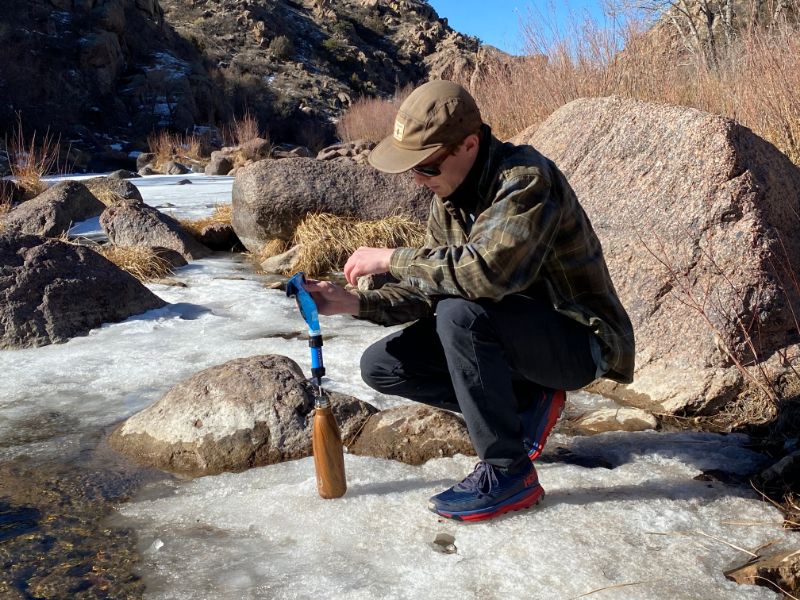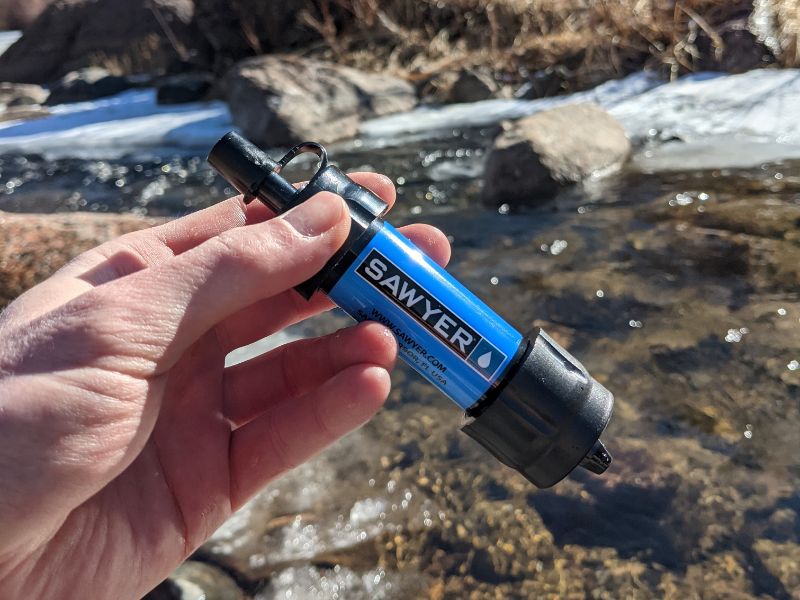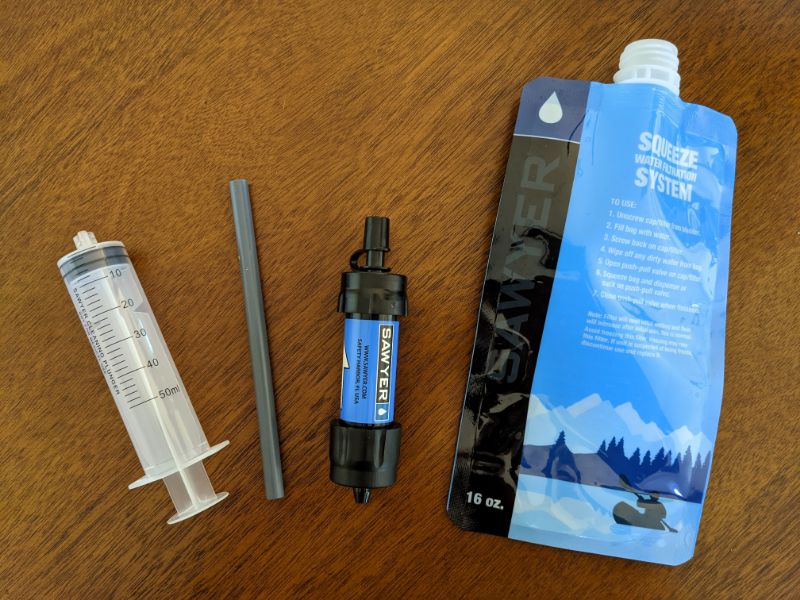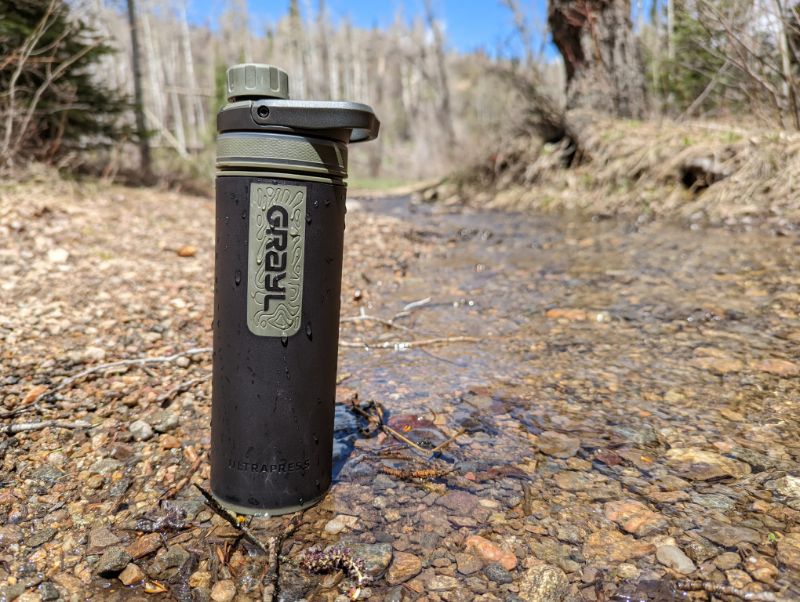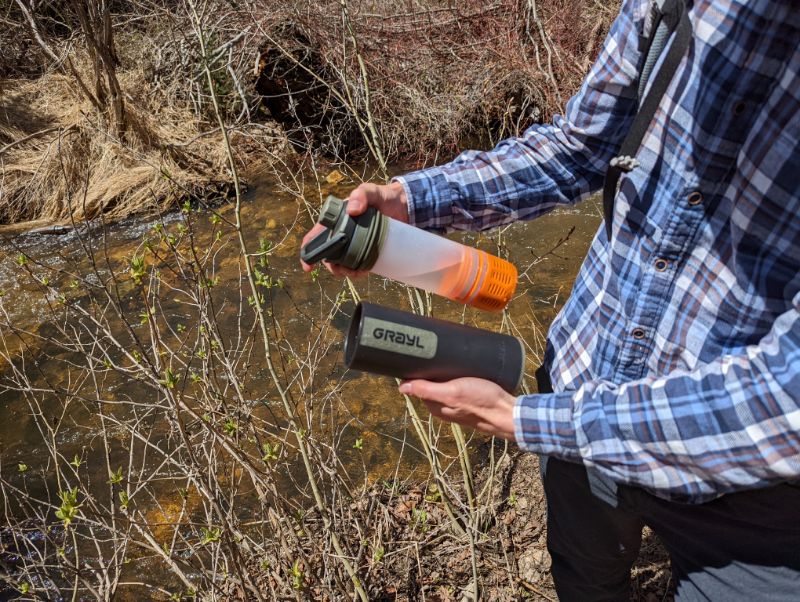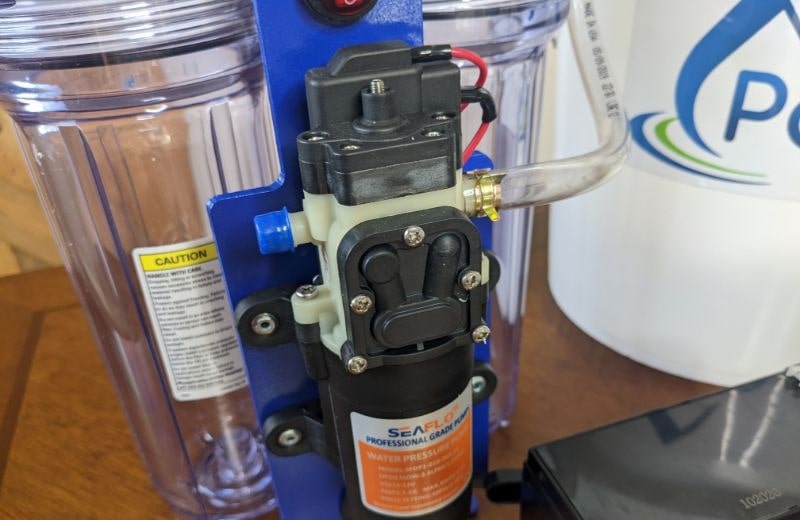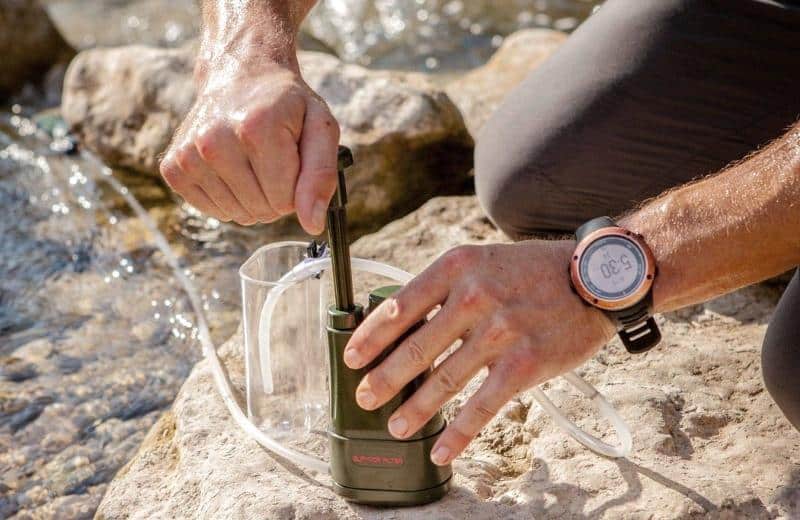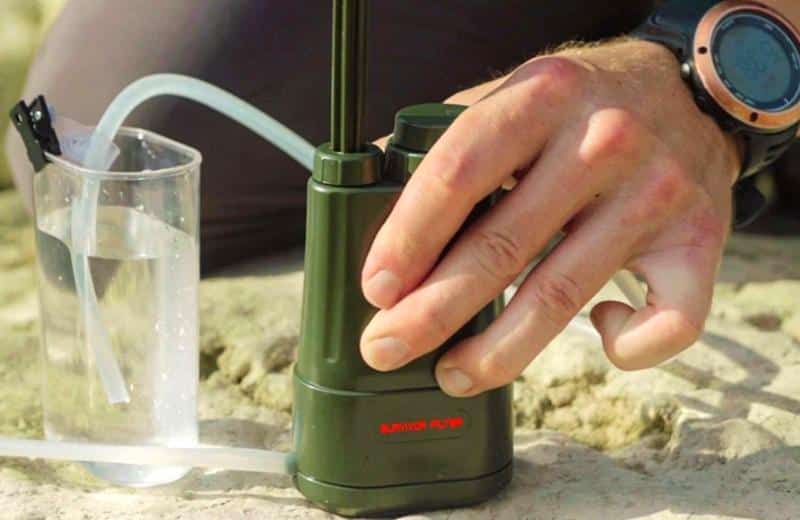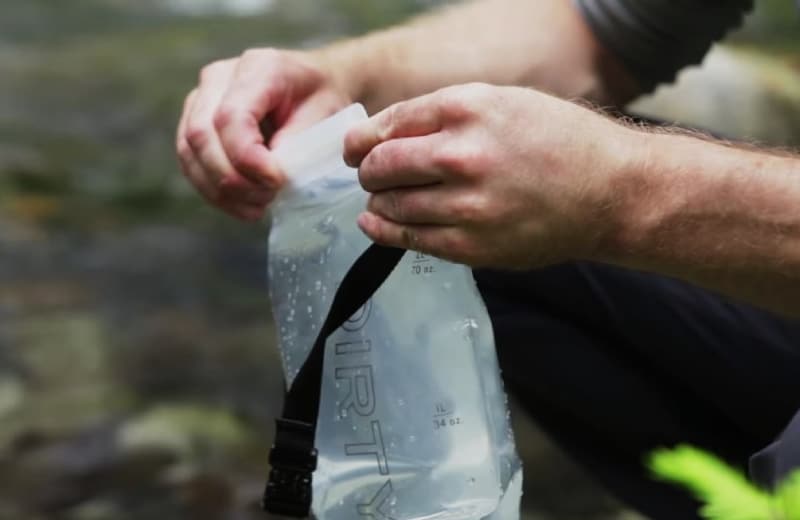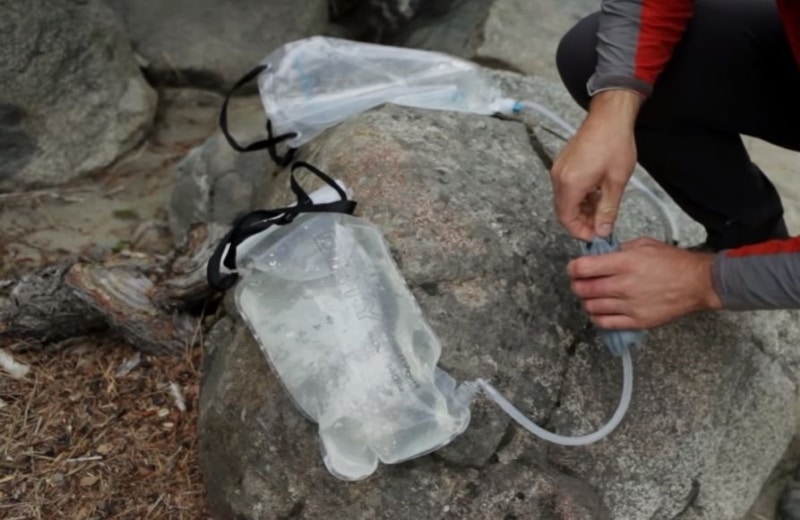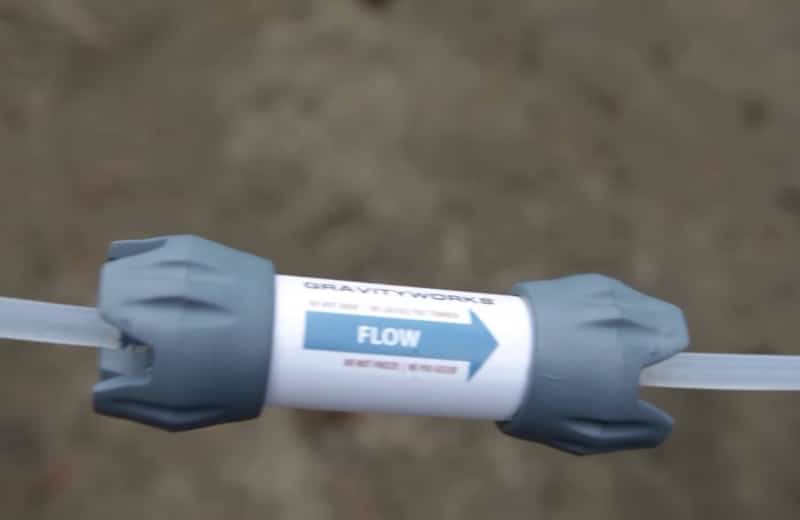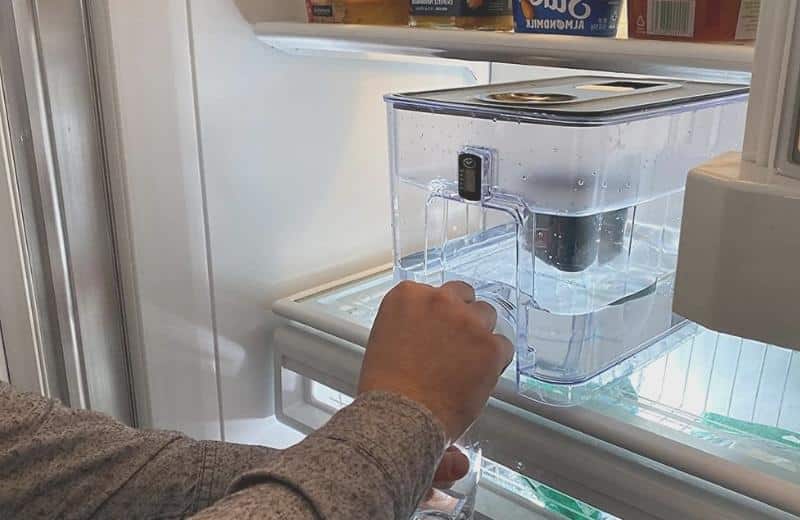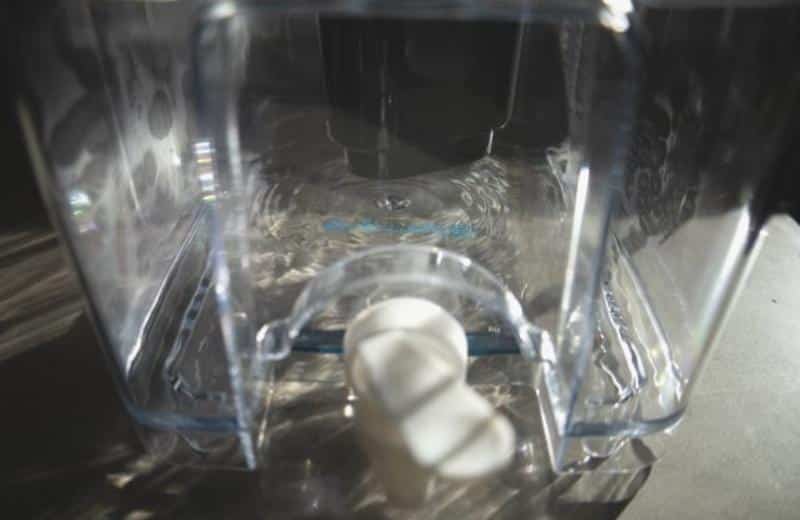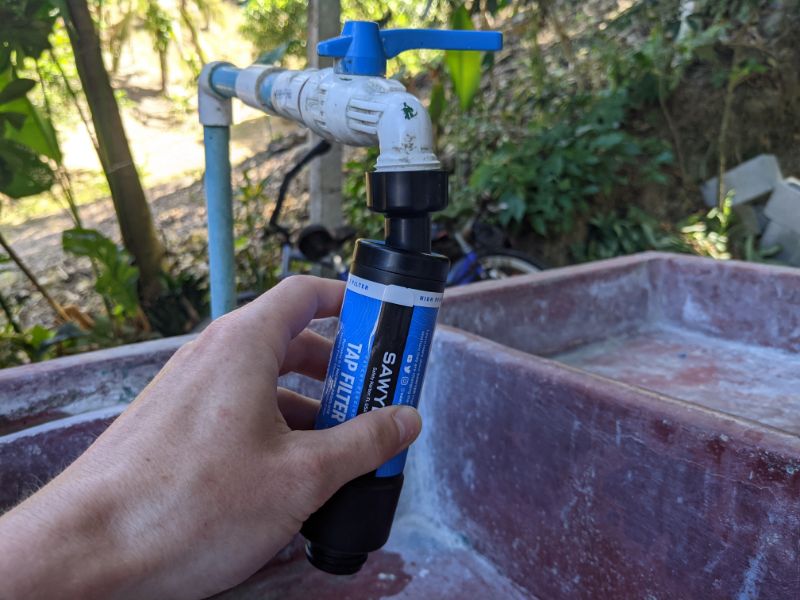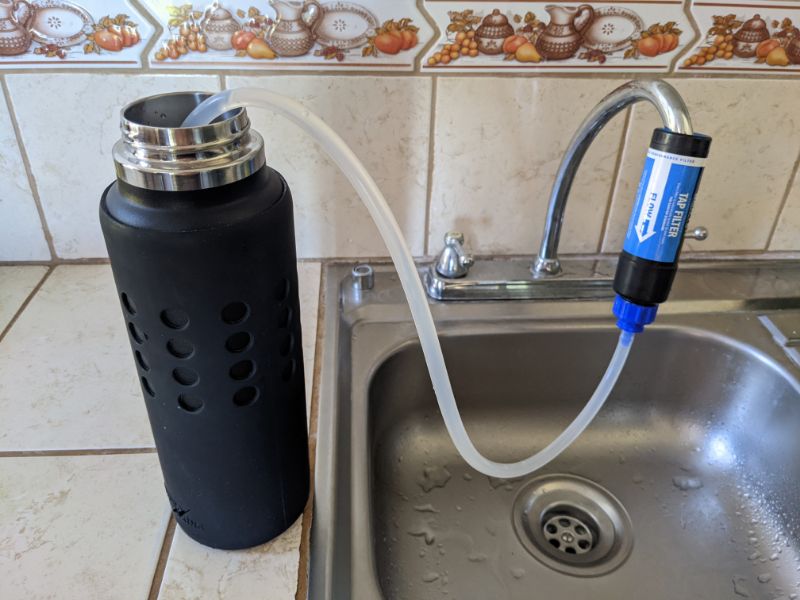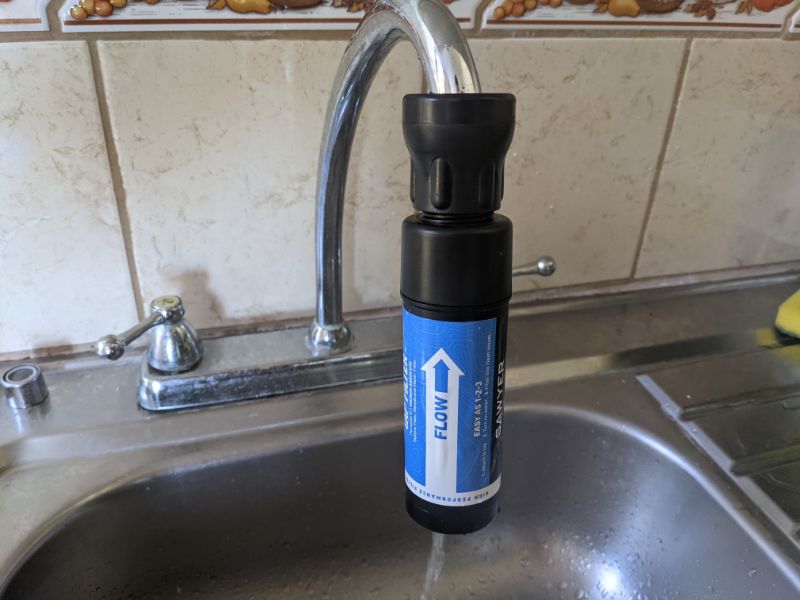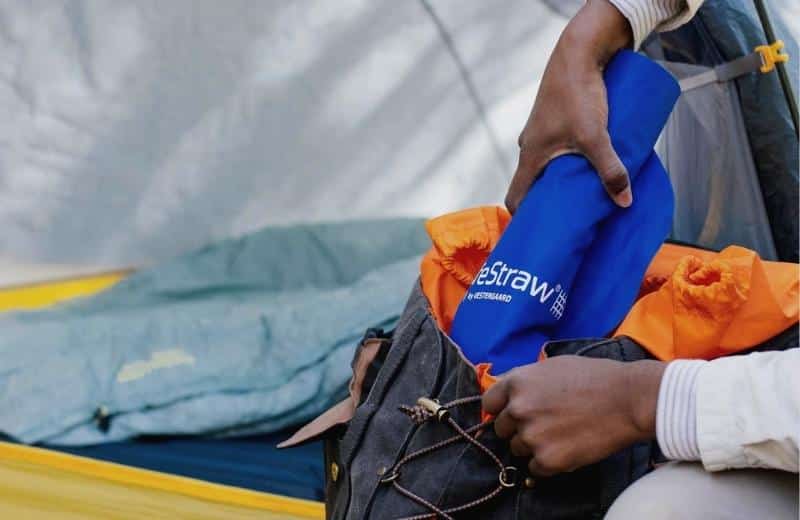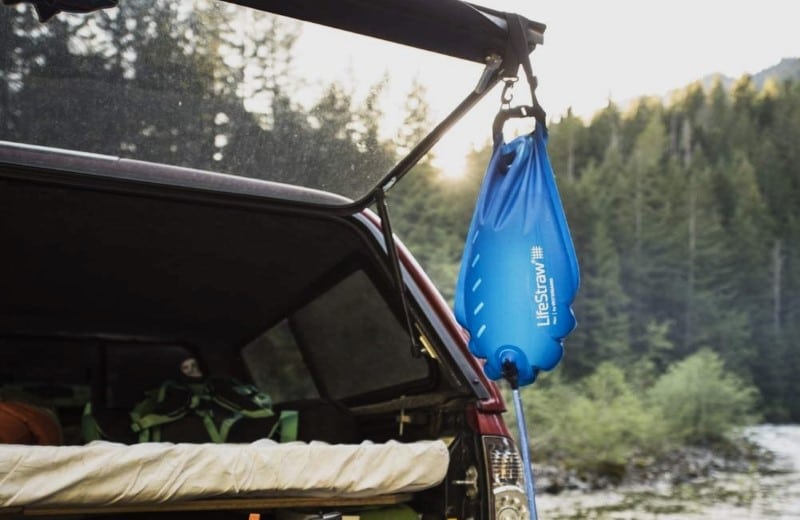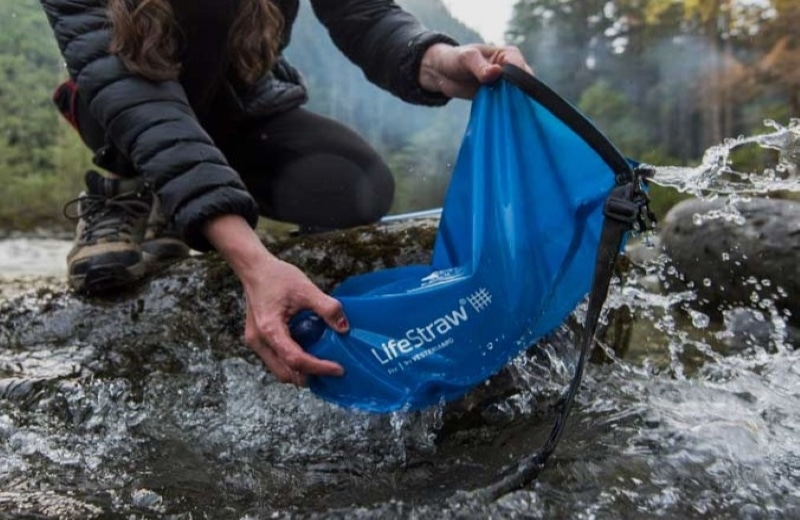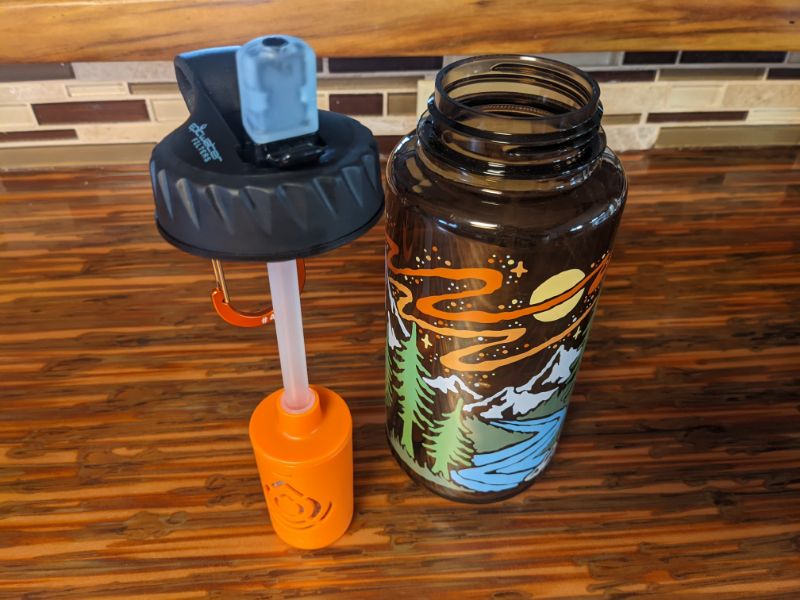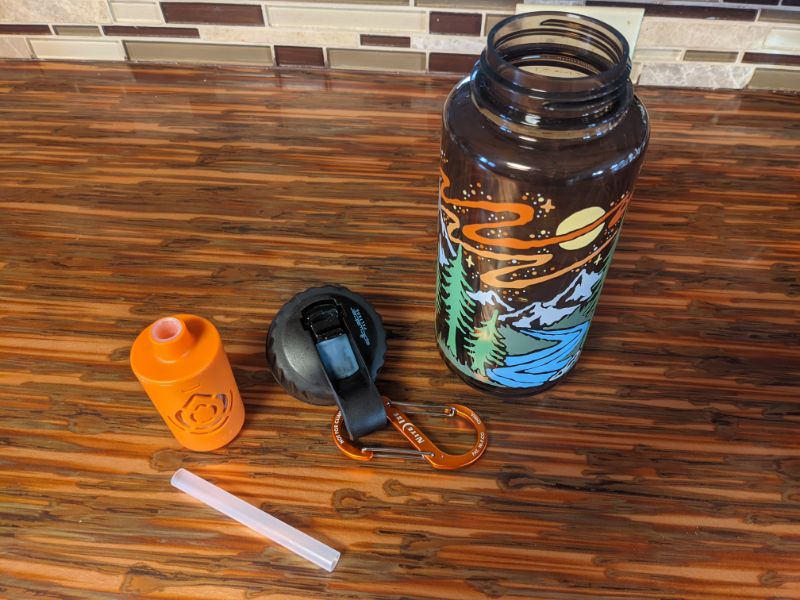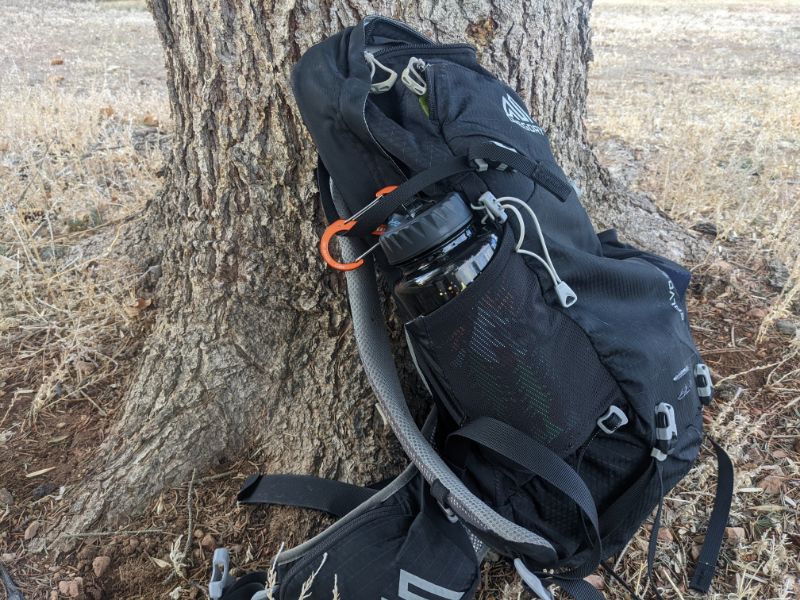The best portable water filter is the Sawyer MINI – but there are other systems better suited for different situations. We’ve reviewed them all here.
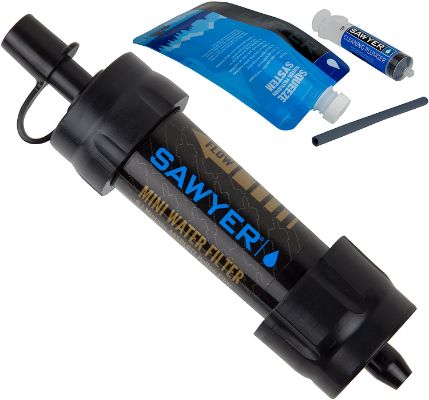
Sawyer Products MINI
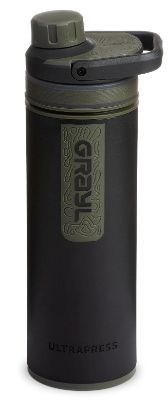
Grayl Ultrapress
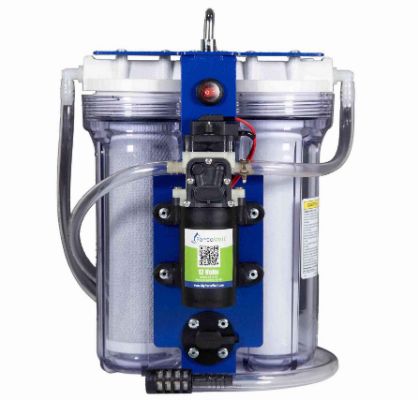
PortaWell
If you’re an outdoor enthusiast, a camper, a hiker, or just someone who loves to explore the world beyond your home, then clean, safe drinking water is an absolute must. When you venture into the wild, there’s no telling what microorganisms might be lurking in the water sources you encounter. That’s where portable water filters come to the rescue, ensuring that your drinking water is pure and free from potential contaminants.
At WaterFilterGuru.com, we understand the vital role that portable water filters play in your outdoor adventures. In this article, we’ve put our expertise to work and compiled a list of the best portable water filters, all rigorously researched and reviewed by our in-house team, to make sure your next venture outdoors is not just memorable but also safe and worry-free.
We’ve scoured the market to handpick the most capable camping and backpacking water filters that meet the demands of outdoor enthusiasts. In this guide, you’ll find our shortlisted picks, which should provide you with the peace of mind that comes with knowing your water is safe, no matter where your adventures take you.
Table of Contents
🥇 Best Portable Water Filters
- Best Overall & Most Versatile: Sawyer Products MINI Water Filtration System
- Top Filtered Water Bottle: Grayl Ultrapress
- Most Water Purified: PortaWell
- Best Pump Style: Survivor Filter PRO
- Top Portable Gravity Filter Bag: Platypus Gravity Water Filter
- Great Holding Capacity: Epic Nano Water Filter Dispenser
- Top Choice for Travel Abroad: Sawyer Tap Filtration System
- Runner Up Gravity Bag: LifeStraw Flex Advanced Water Filter with Gravity Bag
- Runner Up Pump Style: Katadyn Vario Water Filter
- Alternative Pump Style: MSR MiniWorks EX Microfilter Water Filter
- Runner Up Filtered Water Bottle: Epic Nalgene OG
📊 Comparison Chart of Portable Water Filters
| Product | Sawyer Products MINI | Grayl Ultrapress Grayl Ultrapress" />
Grayl Ultrapress" /> | PortaWell | Survivor Filter PRO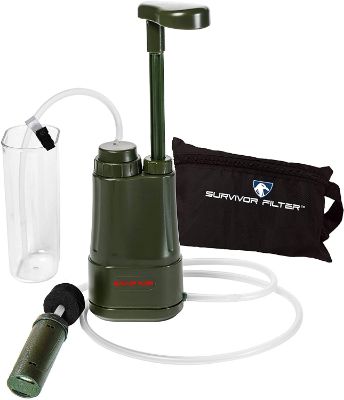 | Platypus Gravity Water Filter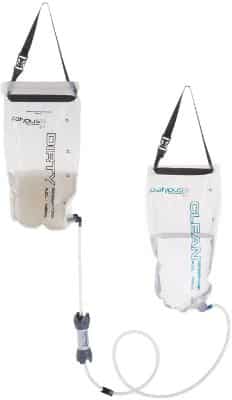 | Epic Nano Dispenser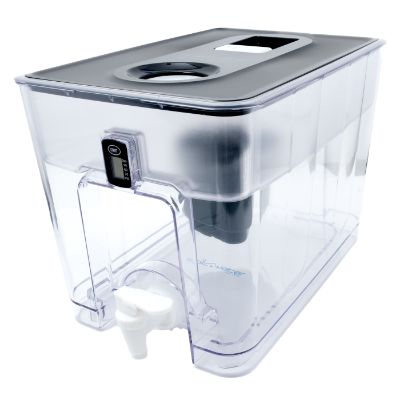 | Sawyer Tap Filtration System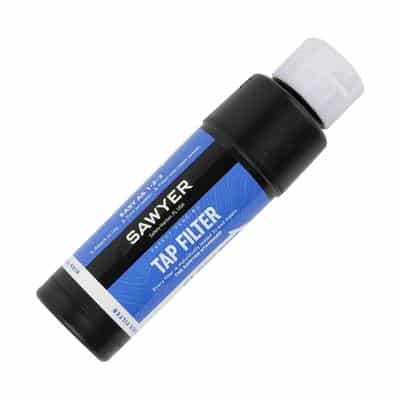 | LifeStraw Flex with Gravity Bag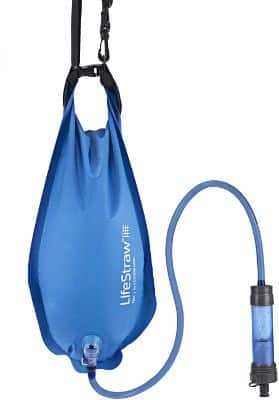 | Katadyn Vario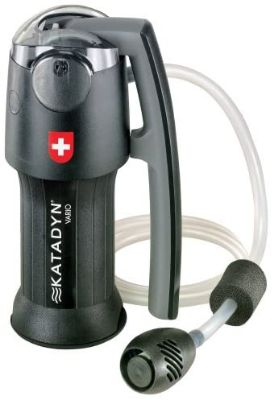 | MSR MiniWorks EX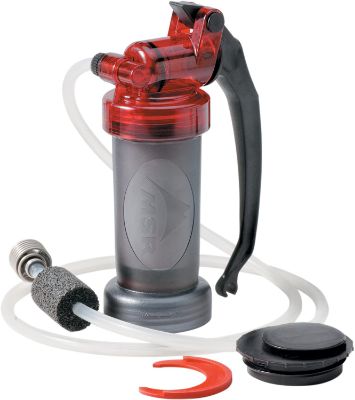 | Epic Nalgene OG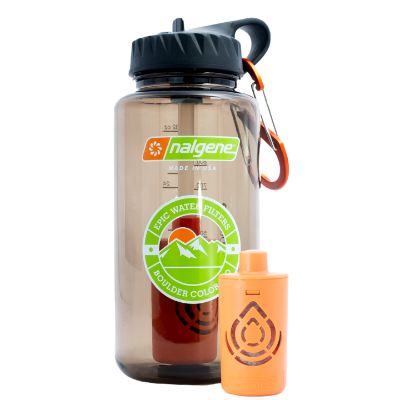 |
|---|---|---|---|---|---|---|---|---|---|---|---|
| Ranking | 1st | 2nd | 3rd | 4th | 5th | 6th | 7th | 8th | 9th | 10th | 11th |
| Ratings | 5/5 | 5/5 | 4/5 | 5/5 | 4.5/5 | 4.5/5 | 4.5/5 | 4/5 | 4/5 | 4/5 | 4/5 |
| Price | $24.95+ | $89.95+ | $359 | $125 | $134.95 | $75 | $45.99+ | $54.95 | $110.87+ | $119.95+ | $43.20 |
| Type | Straw | Bottle | Pump dual filtration | Pump | Gravity | Gravity | Tap Filter | Gravity | Pump | Pump | Bottle |
| Weight | 2 oz | 16.9 oz | <10 lbs | 12.8 oz | 15.2 oz | 4.39 lbs | – | 7 oz | 15 oz | 1.3 lbs | 10.2 oz |
| Filter Capacity | 100,000 gal. | 40 gallons (~300 presses) | Sediment Filter: 6 months; Carbon Filter: 1,000 gallons; Ceramic Filter: 10,000 gallons | Pre-Filter: 100,000 liters; Carbon Filter: 2,000 liters; Ultra Filter: 100,000 liters | 1,500 l | 150 gal. | 500 gal./day | 528 gal. | 500 gal. | 2,000 liters | 100 gal. |
| Pathogen Removal | Bacteria & Protozoa | Bacteria, Viruses & Protozoa | Bacteria, Viruses, Cysts | Bacteria & Protozoa | Bacteria & Protozoa | Bacteria, Viruses, Microbial Cysts | Bacteria & Protozoa | Bacteria & Protozoa | Bacteria & Protozoa | Bacteria & Protozoa | Bacteria, Viruses, Cysts |
| Contaminants Removed | Biologicals & Microplastics | Biologicals, Chemicals, Heavy Metals, Sediments | 200+ | 99% of all Biologicals | Biologicals | 200+ | Biologicals & Microplastics | Biologicals | Biologicals | Biologicals | 70+ |
| Certifications or Testing | USEPA Guide Standard | NSF/ANSI 42 & 53 | Ceramic Filter: NSF 42 | NSF/ANSI | NSF P231 | NSF 42, 53, 401, P473, and P231 | – | NSF 42, 53, 401, P231 | – | NSF P231 | NSF 42, 53, 401, P473, P231 |
| Process | Hollow Fiber Membrane | Mechanical + Carbon + Ceramic | Mechanical + Carbon + Ceramic | Carbon + Ultrafiltration | Hollow Fiber Membrane | Mechanical + Electroadhesion + Ion Exchange | Hollow Fiber Membrane | Activated Carbon + Ion Exchange + Microfilter | Ceramic + Glass Fiber + Activated Carbon | Ceramic + Carbon | Mechanical + Electroadhesion + Ion Exchange |
| Annual Cost | – | $70 – $80 | – | ~$50 | ~$70 | ~$140 | – | ~$40 | ~$50 | ~$40 | ~$90 |
| Warranty | Lifetime | 10 years | 1 year | Lifetime | Lifetime | Lifetime | Lifetime | 3 years | 1 year | Lifetime (limited) | Lifetime |
⭐ Reviews – Best Portable Water Filter 2025

Sawyer Products MINI Water Filtration System
In our opinion, the best overall portable water filter available today is the Sawyer Products MINI Water Filtration System. We love this lightweight backpacking filter because it’s one of the most versatile, longest-lasting, and reliable portable gravity filters on the market, with tiny 0.1 micron pores and an unbeatable 100,000-gallon lifespan.
Specs
| Price | $24.95+ |
| Type | Straw |
| Filter Lifespan | 100,000 gallons |
| Contaminants Removed | 99% of all Biologicals |
| Certifications or Testing | USEPA Guide Standard (1986) and Protocol for Testing Microbiological Water Purifiers |
| Process | Hollow Fiber Membrane |
| Annual Cost | – |
| Warranty | Limited Lifetime |
The Sawyer MINI Water Filtration System is the true definition of multi-functional. Out of the box, it’s a super small, lightweight filter – small enough to fit in the palm of your hand – with a relatively basic design. We tested the filter in three different formats: attached to the included drinking pouch, connected to our own hydration pack, and screwed onto the mouth of a disposable plastic water bottle. We also used it as a straw to drink directly from a water source.
When we got the MINI to review, it cost just under $25 – not bad given just how many roles it can play. The filter has an unbeatable 100,000-gallon lifespan, which is one of the best lifespans we’ve ever seen for a portable water filter, and which Sawyer promises to honor. Our predicted annual spend was $0 given that the filter is supposed to last indefinitely (as long as you clean it properly).
Best For:
People looking for the best, most versatile portable water filter that money can buy. We think the Sawyer MINI is best for everyone because it has a longer lifespan and more uses than any of its competitors.
What We Like:
- Multi-functional with 4 different uses
- Removes 99.99999% of bacteria and 99.9999% of all protozoa
- Lasts a lifetime with proper cleaning
- Affordable upfront cost
What We Don’t Like:
- Clogs quickly
- Needs regular backflushing
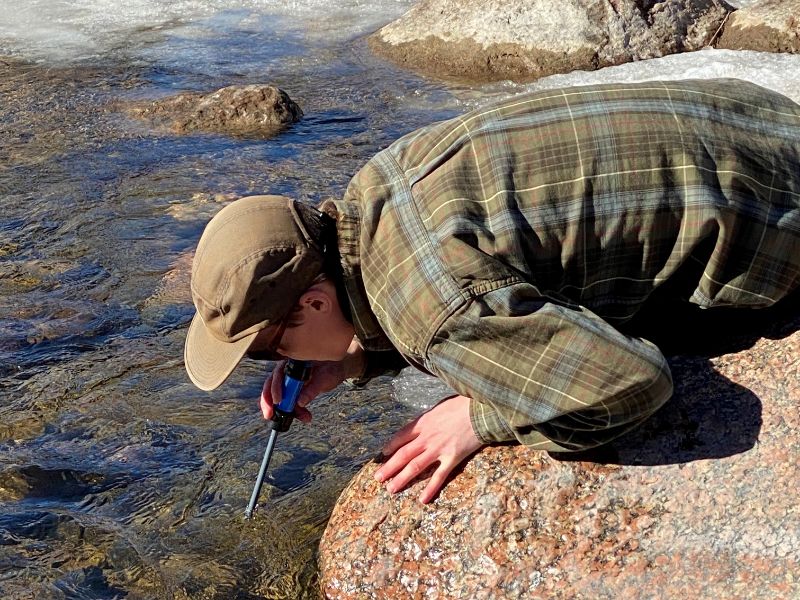
Effective Against Bacteria & Protozoa
The Sawyer MINI uses a hollow-fiber membrane filter, which has a tiny 0.1-micron pore size and traps protozoa (including Giardia and Cryptosporidium) and bacteria (it doesn’t remove viruses). This filter media consists of hundreds of u-shaped tubes that remove tiny contaminants. For some perspective, the average size of a bacterial cell is 0.2 to 1 micron in width and 1 to 10 microns in length.
We found from our experience using this filter on our hiking trip in Colorado that it performs well when treating clear water, but when we tested it with turbid sources, it clogged more quickly. There’s an included syringe that you can use for backflushing the system, but since this took extra effort, we pre-filtered our turbid water through a clean handkerchief before sending it through the MINI filter.
Easy Multifunctional Uses
We were able to test the Sawyer MINI filter in all configurations to find what worked best for us. The included squeeze bag was a useful way to send water quickly through the filter and into our reusable water bottle (or any other container that you want to store clean water in). However, we’re not sure how durable the bag is, and while we haven’t had any issues with it so far, we’ve seen some customers complaining that the bag splits and leaks easily. A way to still be able to use the “squeeze” function to quickly filter water is by attaching a single-use plastic water bottle to the filter, which has a more durable design.
The time it took us to filter water depended on how we were using the filter. We found that drinking straight from the water source using the included straw was fastest (although it required mouth muscles that we didn’t know we had!). Using the squeeze function took slightly longer as we would generally filter a full batch of water before drinking. We could squeeze around 1 liter of water within 2 minutes, depending on the water’s turbidity and sediment levels. We also used the filter as an inline filter at the end of our hydration bladder drinking tube, which worked well, but we wouldn’t use this as our preferred method because of the effort it took to drink through the straw without being able to squeeze water through the filter.
If you’re an avid hiker or camper, you’ll know that every ounce of space matters. The Sawyer MINI weighs just 2 ounces (or around 3.7 ounces including the straw, bag, and syringe), so it didn’t take up much room or weigh our rucksack down.
Read the Full Review: Sawyer MINI Water Filter Review See also: Lifestraw vs Sawyer MINI Comparison (2022)

Grayl Ultrapress
The Grayl Ultrapress is our top pick for the best portable water bottle filter. In our testing, this system blew us away with its simplicity of use. There are no catches – this water filter bottle really is one of the easiest-to-use portable filters we’ve ever tried.
What else can you expect? 99.9% of waterborne pathogen removal, 10-second filtration time, and long filter lifespan. More on these features below.
Specs
| Price | $89.95+ |
| Type | Bottle |
| Filter Lifespan | 40 gallons (~300 presses) |
| Contaminants Removed | Biologicals, Chemicals, Heavy Metals, Sediments |
| Certifications or Testing | NSF/ANSI 42 & 53 |
| Process | Electroadhesion + Activated Carbon |
| Annual Cost | $70 – $80– |
| Warranty | 10 years |
When we unpackaged the 16.9-ounce bottle, we were pleased with its design functionality, appearance, and durability. The bottle has a compact, slim design that fitted in our standard-sized backpack bottle pockets, and it felt sturdy and durable (it can apparently withstand drops of up to 10 feet while full). The bottom and sides of the bottle are coated with non-slip rubber, which made the bottle easier to carry and press (more on pressing later). However, as expected, it is significantly heavier than other portable filters at 12.5 ounces without any water, and the half-gallon water capacity meant we knew we’d have to refill it often.
Coming in at just under $90 for the Nature Edition (the bottle we went for), the Grayl UltraPress isn’t cheap for a filtered water bottle. But it removes more contaminants than many of the other popular bottle filters sold for hiking and backpacking use, so we did feel that the price was justified. Our estimated annual spend was around $70-$80 – again, more expensive than many of the other filters on this list, so something to keep in mind when you’re determining your budget.
| GRAYL UltraPress Options | Price |
|---|---|
| Nature Edition | $89.95 |
| Covert Edition | $89.95 |
| UltraPress Ti | $199.95 |
Best For:
Anyone looking for a super convenient, no-nonsense portable water filter with no fiddly parts or long wait times for filtered water. We recommend the Grayl UltraPress for beginners and impatient hikers because it’s quick and simple to use.
What We Like:
- Durable, attractive design
- Easy-use press filter function
- Quick filtration
- Removes 99.99% of bacteria, viruses, cysts, & other contaminants
What We Don’t Like:
- Quite expensive
- Filter life is quite short

Removes Viruses, Cysts, Bacteria, & More
Let’s start with contaminant removal. We were initially impressed with the Grayl UltraPress because unlike many of the other portable filters we tested, it has a carbon filter as well as an electroadsorption filter, which meant it could remove viruses (not all filters we tested could do this), bacteria, cysts, and other chemicals and metals.
While pathogens are our biggest concern in natural water sources, we know that there are other pollutants present in many of these water supplies that are still very dangerous, even if they don’t have gastrointestinal effects. Some of the other dangerous contaminants that the filter can remove include pesticides and herbicides, heavy metals, PFAS, heavy metals, VOCs & other chemicals. The carbon filter also improved the taste and smell of our water, so of all the portable filters we tested, our water tasted the most pleasant from this one.
As for proof of performance, the filter has been independently tested by a certified lab to meet, or exceed NSF Standards 42 and 53 for sediment, pathogen, and chemical removal. Plus, it meets the EPA Guide Standard and Protocol for testing microbiological water purifiers, which means it should live up to the manufacturer’s performance claims and won’t make you sick.
Simple Push Filtration
We tested the Grayl UltraPress on water from streams, rivers, and lakes in Colorado. What we particularly loved about this water bottle was that, unlike most of the other portable filters available, we didn’t have to fuss around with setup and juggle a number of different attachments. Plus, the bottle’s push filtration meant we didn’t have to wait around for water to filter by gravity or lose energy sucking through a straw filter.
We simply filled the bottle with water and placed it on a stable surface, put the lid on, and pressed down on the lid to send water through the filter. The whole process took less than 10 seconds (which works out at a flow rate of around 3 liters per minute) and couldn’t have been easier. The bottle cap vents the bottle, which means there’s not a whole lot of unnecessary resistance during pushing.
The 40-gallon filter life is definitely not the best we’ve seen for a portable water filter, which is likely because it can’t be backflushed to extend its lifespan. The filter lasts the longest if you use clear water – but we didn’t get to pick and choose between water sources in the wilderness. Again, when our only water sources were turbid, we filtered them in a homemade cloth filter to remove the sediment before filtering them with the bottle.
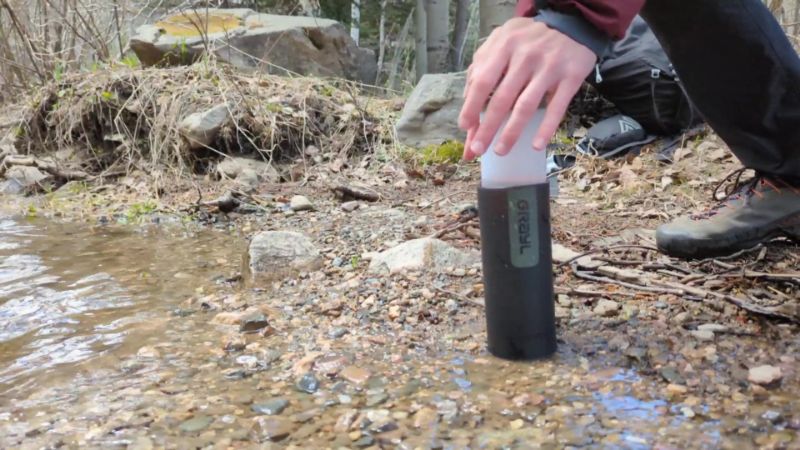
Read the Full Review: Grayl UltraPress Review

PortaWell
Based on our testing, the PortaWell filter is our top choice for the best portable water filter with the most water purified. This is because the system has a durable, high-quality electric pump filtration system that filters water at a rate of up to 60 gallons per hour, making it ideal for large families and big groups.
The PortaWell is much heavier and clunkier than the Grayl and Sawyer filters, and it won’t easily fit in your rucksack – but it’s a fantastic choice for filtering batches of water at a camping or hiking base before heading off on your adventures.
Specs
| Price | $359 |
| Type | Pump dual filtration |
| Filter Lifespan | Sediment Filter: 6 months Carbon Filter: 1,000 gal. Ceramic Filter: 10,000 gal. |
| Contaminants Removed | 200+ |
| Certifications or Testing | Ceramic Filter: NSF 42 |
| Process | Mechanical + Carbon + Ceramic |
| Annual Cost | Varies |
| Warranty | 1 year |
Straight away, the obvious difference between the PortaWell Water Filtration System and most of the other portable water filters we tested is that the PortaWell system is significantly bigger and is not intended as a backpacking filter. This system consists of two filters (three come with the unit, but you mix and match so you’re only using two at a time) a battery-operated pump, and a 5-gallon bucket for collecting water. It weighs 15 pounds and is too bulky to consider carrying in a backpack, so we tested the system at our camping base only.
At the time of our review, the PortaWell Filtration System cost around $329 – so it’s not cheap. The reason for the higher cost is simply that you get a whole lot more than any of the small, handheld filters, including three filter stages and a battery, so the price (though out of some budgets) is pretty fair. We found it difficult to determine an annual cost because it depended heavily on how, and how often, we used the system.
Best For:
Families and groups of people looking for a portable water filter to use at their camping or hiking base. We think the PortaWell is better than most other options for large groups because its electric pump supplies a speedy filtered water flow rate of 40-60 GPH.
What We Like:
- Mix and match filters to suit your filtration needs
- Easy to use – no hand-pumping required
- Decent filter lifespan
- Targets a greater range of contaminants than other portable filters
What We Don’t Like:
- Setup takes a long time
- Battery sold separately
Mix and Match Filters to Remove a Range of Contaminants
Most of the pump filters we’ve tried use just one or two filters, which typically target pathogens and not much else. The PortaWell Filtration System offers a more comprehensive performance because there are three filters to use (a 1-micron sediment filter, a carbon block filter, and a 0.5-micron absolute ceramic filter), each removing its own set of contaminants. Our only gripe was that the unit only fits two filters, so to use them all, we’d have to run water through the system twice, swapping filters after the first run-through.
We found that the absolute ceramic filter and the sediment filter were the best combination for treating surface water containing pathogenic bacteria and sediment. If you want to also remove pesticides, herbicides, and VOCs from your water, run it through the ceramic filter and the sediment filter first, then swap one of the filters for the carbon block filter and repeat the process.
Electric Pump Filtration
Setting up and using the PortaWell system takes more effort than the bottle, straw, and gravity filters we reviewed. There were tubes, filters, batteries, buckets, and cables to organize before we could start filtering water. But once we’d sorted the setup, the filtration process itself was super simple and hands-off.
The PortaWell uses a battery-powered pump to send water quickly through the filter stages. This was instantly appealing to us for two reasons: we didn’t have to exert any of our own energy with a hand pump, and we’d be able to access filtered water in a matter of seconds. In our testing, it took us just over 1 minute to filter 1 gallon of water – about 2.5 times the speed of a hand-pump filter. And we simply sat back and watched the electric pump do all the hard work – ideal!
Something to note, however, is that the battery isn’t included with the upfront purchase. You can either buy the battery for an extra $40 or so on the PortaWell website or use your own 12-volt battery. Honestly, that didn’t make much sense to us given that the battery is essential for the pump’s operation – there’s no option to pump manually if you don’t buy the battery.
The 1,000-gallon carbon filter lifespan is decent, and the 10,000-gallon ceramic filter lifespan is even better. We could renew the ceramic filter’s flow rate by washing it under running water up to 30 times.
Read the full review: PortaWell Review

Survivor Filter PRO
We recommend the Survivor Filter PRO as the number 1 pump-style portable water filter. This system uses three filter stages to remove pathogens, heavy metals, chemicals, and more, and boasts a supr small pore size of 0.01 microns.
As a hand-pump system, this Survivor Pro filter takes more work and has a significantly slower flow rate than the PortaWell system – but it costs one-third of the price and achieves virtually identical results.
Specs
| Price | $125 |
| Type | Pump |
| Filter Lifespan | Pre-Filter: 100,000 liters Carbon Filter: 2,000 liters Ultra Filter: 100,000 liters |
| Contaminants Removed | 99% of all Biologicals |
| Certifications or Testing | NSF/ANSI |
| Process | Carbon + Ultrafiltration |
| Annual Cost | ~$50 |
| Warranty | Lifetime |
The Survivor Filter Pro is small and lightweight, and there are quite a few vials, tubes, and syringes, a drinking cup, and a travel bag to account for – it has the look of a beginner’s chemistry kit! But a quick read of the instructions makes it obvious what the different components are intended for, with the pumping device being central to the rest of the other items. The unit weighs just 12.8 ounces, so it’s around 10 times heavier than our top pick Sawyer MINI – but it’s still definitely lightweight and small enough to carry in a backpack.
The cost of the unit when we reviewed it was just under $100 (this was during a sale that brought the price down from $125). Yes, that’s quite an upfront investment. But given the impressive lifespan of the filters, we didn’t expect to pay a recurring annual cost for maintenance, making the system a very affordable long-term solution.
Best For:
Folks who want the benefits of a pump-style filter and are happy to put in the work to filter their water. The Survivor Filter PRO is much smaller than the PortaWell (it looks a lot like a soap dispenser) so it’s suitable for taking with you on the go.
What We Like:
- Smaller and lighter than most pump filters
- No heavy battery required
- Incredibly thorough 0.01-micron filtration
- WQA Gold Seal and backed by a 100% satisfaction guarantee
What We Don’t Like:
- Lots of components to carry
- Requires more effort than most other portable filters
Three-Stage Pump Filtration
The Survivor Filter PRO uses hand pumping to send water through an ultra filter pre-filter, a carbon filter, and an internal ultra filter. Like the PortaWell, the filter only has room for two stages in the housing itself – but the pre-filter is attached to the rest of the unit via a flexible tube.
Assembling the filters and pump admittedly takes more work, and it’s not something you want to do on the go – it’s best to have a flat surface to lay out all your parts and attach everything together. The pre-filter is attached to the end of the inlet tube and the carbon filter and ultrafilter are inside the pump device. Once the tubes and filters are attached to the pump, it’s easy to use: just drop the inlet tube end into the water and put the outlet tube in the included cup (or your water bottle of choice), then pump the handle to draw water through the filters and into the cup. The pumping process takes quite a lot of energy and produces filtered water quite slowly, but it’s not a bad option for single or two-person use. We recommend pumping water into a bottle rather than the cup, which is small, lightweight, and not very stable while trying to fill it.
Superior Contaminant Removal
The level of filtration in this Survivor filter is excellent. No other filter on this list can filter down to 0.01 microns – even our top pick Sawyer filter only filters to 0.1 microns. This filter removes 99.999% protozoa (including giardia, cryptosporidium, and parasites), 99.999% of a single type of tested virus (Phi X-174), bacteria, and staph, 93% lead, and 99.5% mercury. The filter also removes chemicals and pollutants from water. It has a WQA gold seal for its performance, which means it’s proven safe for use and effective at performing as claimed by the manufacturer.
There are three filters to maintain in the system: the ultra pre-filter and internal ultra filter both last up to 100,000 liters, or around 25,000 gallons, while the carbon filter lasts for 2,000 liters, or around 440 gallons. The included backflushing syringe can be used with the ultra pre-filter and ultra filter to extend their lifespan.

Platypus Gravity Water Filter
In our opinion, the Platypus Gravity Water Filter is the best portable gravity filter bag. Why? Because this system has one of the biggest capacities and fastest flow rates of any hanging gravity filter, and is ideally sized for families and groups.
What else do we love? Bacteria and protozoa removal that meets EPA and NSF guidelines, BPA-free design, and a 1,500 liter (329 gallon) lifespan are all standout features of this filter.
Specs
| Price | $134.95 |
| Type | Gravity |
| Filter Lifespan | 1,500 liters |
| Contaminants Removed | 99% of all Biologicals |
| Certifications or Testing | NSF P231 |
| Process | Hollow Fiber Membrane |
| Annual Cost | ~$70 |
| Warranty | Lifetime |
The GravityWorks system comes with two bags: one labeled “clean” (for filtered clean water) and one labeled “dirty” (for unfiltered dirty water). Each bag holds 6 liters of water, with a storage capacity of 12 liters total. The bags are connected by a flexible tube, with an inline filter attached to this tube. It weighs just 11.45 oz and is a good size for a backpack, especially since you can fold the bags to fit them around other items. Based on its size and filtration process, we think it’s best for groups of 1-3 people, 4 at a push.
At the time of our review, the system was priced at around $135 upfront, and there are a few reasons why we think it’s more expensive than similar systems: it’s larger and holds more water, and the bags are much thicker and better-quality than some of the other gravity bag filters we’ve tested, so they should be much more durable. Our estimated annual maintenance cost was less than $70.
Best For:
Anyone who wants a lightweight, pump-free portable filtration solution and doesn’t mind waiting several minutes for a full batch of water to be filtered.
What We Like:
- Easy to use
- Hands-free filtering
- Good water storage volume
- Tested to remove bacteria & protozoa
What We Don’t Like:
- Expensive
- Heavy sediment causes clogging
Gravity Hollow Fiber Filtration
The Platypus Gravity Water Filter uses a small filter cartridge that’s made from hundreds of hollow fibers, which are packed together and have a pore size of 0.2 microns. This is small enough to remove all bacteria and protozoa, including cryptosporidium and giardia. Note that it doesn’t remove viruses, so it’s not guaranteed to make water in developing countries safe to drink.
The filter can treat pretty much any natural water source regardless of turbidity, and the water in the “clean” bag is just that: clear, fresh, and close to odor-free. However, you’ll likely find that high turbidity water clogs the filter, so it’s best to pre-filter water with a lot of sediment. With relatively sediment-free water, our filtration time was just under 1 minute per liter – not bad at all.
Using the Platypus Gravity Water Filter is a piece of cake. It’s easy to connect the two filter bags, and there’s no pumping or technical setup involved. Hanging gravity filters can sometimes be flimsy, and we’ve used a few that end up being trashed after their first outing – but the Platypus Gravity Water Filter has a solid, durable design that seems resistant to splits and punctures. We like that the filter comes with a universal bottle adapter, so you can bypass the bag and filter water directly into a water bottle of your choice.
In terms of maintenance, this is pretty easy. The filter is designed to filter up to 1,500 liters of water, or just over 300 gallons. You can backwash the filter by flipping it the other way and flushing it out with water from the “clean” bag whenever needed, which should improve its flow rate and extend its lifespan. Once the backflush stops working, it tells you that you need to replace the filter.

Epic Nano Water Filter Dispenser
Based on our testing, the best portable water system with a great holding capacity is the Epic Nano dispenser. It’s rare to find a water dispenser that’s capable of removing pathogens, but the Epic Nano has been tested to industry standards to remove bacteria, viruses, giardia, cryptosporidium, and more. View the test results here.
Specs
| Price | $75 |
| Type | Gravity |
| Filter Lifespan | 150 gallons |
| Contaminants Removed | 200+ |
| Certifications or Testing | NSF 42, 53, 401, P473, and P231 |
| Process | Mechanical + Electroadhesion + Ion Exchange |
| Annual Cost | ~$50 |
| Warranty | Lifetime |
The Epic Nano is another filter that’s not portable in the backpacking sense – but it uses gravity filtration, which means it filters water in any location without the need for electricity or water pressure, and it’s one of the few water dispensers we’ve tried that can filter natural water sources. We’ve used this system on a handful of occasions when camping and RVing, and we find that it’s ideal for setting up near the campfire to provide access to filtered water at our base.
When we got the Epic Nano Dispenser to test, it was priced at around $60 – not bad at all given that it can remove more than 200 contaminants (more on this later). But the filter lifespan is significantly lower than some of the other portable water filters we’ve tested, at just up to 150 gallons, which meant we were looking at replacing the filters every 3 months or so (our estimated annual spend was around $50).
Best For:
Families or groups looking for a no-fuss gravity filter that can be filled and used for camping or emergencies. The Epic Nano is lightweight and portable (but not small enough to be carried in a rucksack) and has a decent holding capacity of up to 1.5 gallons of water.
What We Like:
- Removes 200+ contaminants
- Good 1.7-gallon water holding capacity
- Requires no pumping or sucking through a straw
- Easy to assemble & use
What We Don’t Like:
- Short filter lifespan
- Slow gravity filtration
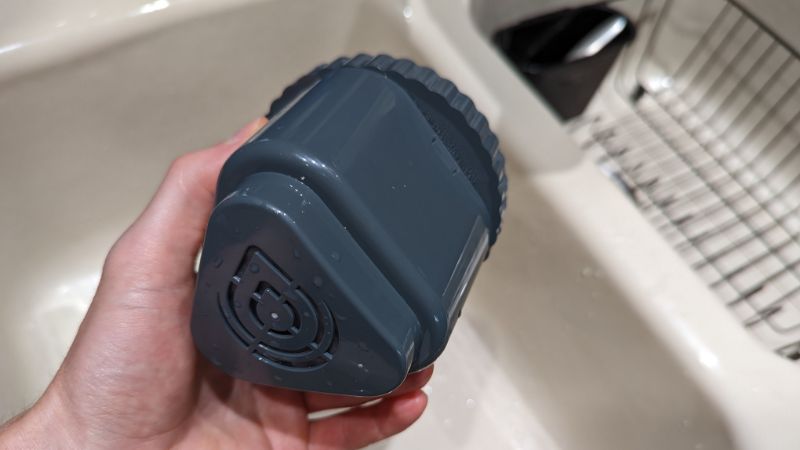
Gravity-Based Water Dispensing
Of all the portable water filters we tested, the Epic Nano was one of the easiest we used and had the simplest, most self-explanatory design. It doesn’t have any small, fiddly components like some of the systems we tested – it’s a simple, clear water container with a top and bottom reservoir, which are separated by the filter. We were able to assemble the dispenser in a matter of minutes, then we could simply add unfiltered water to the top chamber and leave it to filter through into the bottom.
The filter uses gravity filtration to filter out contaminants at a steady rate. It’s rare to find a dispenser like this one, which has a filter design to remove Virus MS2 Phage (99.95%), lead (99.4%), E.Coli (99.9999%), giardia (99.909%), and cryptosporidium (99.999%). A major benefit of this system for us was that it doesn’t only target microorganisms – it can also remove hundreds of other common contaminants that you might find in your source water, like fluoride, arsenic, VOCs, pesticides, lead, PFOS, and PFOA. It’s reassuring that the filter is tested to NSF Standards (although, of course, an official NSF certification would be better).
While the filter doesn’t last as long as most of the other portable filters we’ve tested, it is one of the few that has a built-in filter countdown timer, which meant we didn’t have to make a manual note of when the filters needed replacing. Keep in mind that the timer is just that – a timer – and isn’t based on filter quality.

Sawyer Tap Filtration System
In our opinion, the Sawyer Products SP134 TAP Water Filtration System is the most reliable portable filter for taking abroad. You can use this filter to purify any foreign tap water source as it connects to most faucets. Attach the filter to a tap, hose bib, or faucet aerator, or attach it to other Sawyer filters (like the Sawyer MINI) to stay safely hydrated in developing urban locations.
Specs
| Price | $45.99+ |
| Type | Tap Filter |
| Filter Lifespan | 500 gallons per day |
| Contaminants Removed | 99% of all Biologicals & 100% microplastics |
| Certifications or Testing | – |
| Process | Hollow Fiber Membrane |
| Annual Cost | – |
| Warranty | Lifetime |
The Sawyer TAP Water Filter is a bit different from many of the other portable water filters we tested. Rather than being intended to use to filter natural water sources, the TAP filter (as the name suggests) connects to a tap. That could be any faucet at a kitchen sink, a camper van or RV, or even a campsite hose bib. As long as the faucet measures between 11/16 inches and ¾ inches, the filter should fit it.
The filter was around $43 when we got it to review, which we actually think is great value given that, like most Sawyer products, it has a super long lifespan – it’s supposed to last 10+ years with proper care and maintenance. That means no annual maintenance cost to worry about for at least a decade.
| Sawyer Tap Filtration System Options | Price |
|---|---|
| Water Filtration | $45.99 |
| Water Filtration + Coupling | $48.98 |
| Water Filtration + SP128 Water Filtration | $66.82 |
| Water Filtration + SP129 Water Filtration | $74.99 |
| Water Filtration + Seals | $49.28 |
| Water Filtration + Water Purification Tablets | $61.45 |
Best For:
Anyone planning to travel to a developing country who wants to treat potentially contaminated domestic water for drinking or cooking.
What We Like:
- Attaches to most faucets
- Removes all bacteria, protozoa, & microplastics
- Very long 10,000-gallon filter life
- Affordable
What We Don’t Like:
- Can only be used when connected to a faucet
- Not guaranteed to be compatible with all faucets
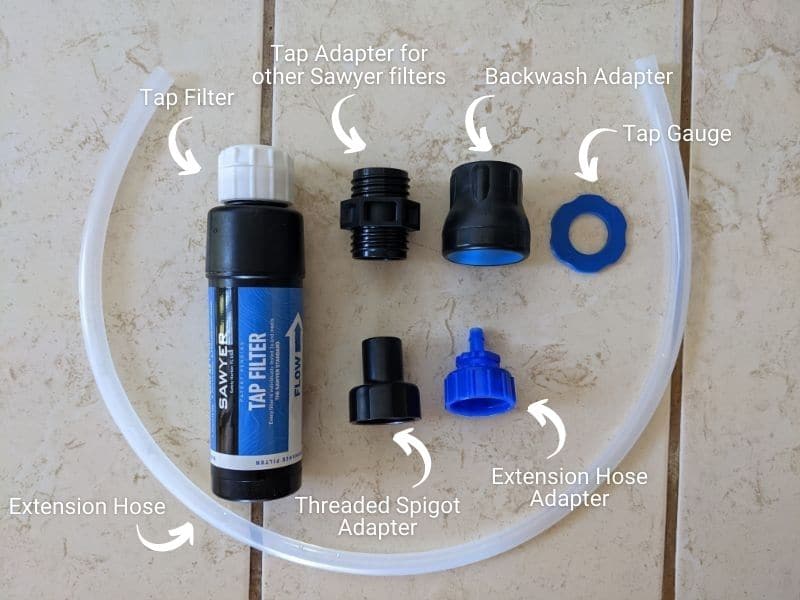
Reliable Faucet Filtration
We tested the Sawyer TAP Water Filter both on our own drinking faucet in Colorado and on several hotel faucets during our trip to South America. From our own experience, we think the system is expertly designed for easy use on your travels. Weighing just 4 ounces, it’s lightweight and compact enough to slot into hand luggage, and comes with everything needed for a quick setup (including a filter, backwash adapter, various adaptors for faucets, a tap gauge, and an extension hose for shallow sinks).
The 0.1-micron absolute inline filter can protect you from contaminants in poor-quality domestic water, including 99.99999% of bacteria (E.Coli, salmonella, and cholera); 99.9999% of protozoa (cryptosporidium and giardia); and 100% of microplastics. The filter’s contaminant removal abilities are impressive, and we were pleased to see that its performance is backed by independent testing from various US-based laboratories. We haven’t yet been able to test our water quality before and after using this filter, but we definitely noticed an improvement in the taste and smell of the water filtered through the system. We also love that each Sawyer filter is tested three times during manufacturing before being packaged for selling. The likelihood of ending up with a faulty product is minimal.
While we didn’t need to use this Sawyer filter in our own home, we enjoyed having an emergency filter on hand that we could attach straight to our faucet to access clean water in the event of a boil water notice being issued.
Read the Full Review: Sawyer Tap Filtration System

LifeStraw Flex Advanced Water Filter with Gravity Bag
Our runner-up gravity bag filter is the LifeStraw Flex. This hanging gravity filter can be used as a personal straw filter to drink straight from a stream or a lake, attached to your water bottle or the included bag for gravity water filtration, or used as an inline water filter with your own water hydration pack.
What makes this filter our second choice gravity bag filter, and not the first? The LifeStraw Flex is just as versatile as our top pick, the Platypus Gravity Water Filter, and has a bigger capacity (528 gallons vs 329 gallons) – but the Flex is backed by a shorter 3-year warranty and doesn’t quite match the Platypus in design quality and durability.
Specs
| Price | $54.95 |
| Type | Gravity |
| Filter Lifespan | 528 gallons |
| Contaminants Removed | 99%+ of all Biologicals |
| Certifications or Testing | NSF 42, 53, 491, P231 |
| Process | Activated Carbon + Ion Exchange + Microfilter |
| Annual Cost | ~$40 |
| Warranty | 3 years |
There are just three parts to this system: the bag, the hose, and the LifeStraw Flex filter. The best way to use the filter is to hang it from a tree branch, so you have a higher starting point that’ll make it easier for water to flow down through the filter and into your bottle (or whatever you want to fill). There’s only one bag in this setup, which holds 1 gallon of dirty water. This water flows down through the flexible tube and through the filter, before emerging as filtered water from the nozzle.
The LifeStraw Flex was a great price when we reviewed it, at around $55. We estimated that we’d spend less than $40 per year on system maintenance, which isn’t bad at all. The filter has an impressive lifespan of up to 528 gallons, or just over 2,000 liters of water, so it should last at least a year before it needs replacing.
Best For:
Anyone looking for an affordable alternative to the Platypus Gravity Water Filter with a slightly longer lifespan and a lower annual spend. The LifeStraw Flex is manufactured by a trusted, reliable brand, so you can be certain that you’re still getting a fantastic-quality product, despite spending less.
What We Like:
- More affordable than the Platypus filter
- Durable, rugged design
- Only 1 bag to deal with
- Small & lightweight
What We Don’t Like:
- Slower 0.125 gal/min flow rate (the Platypus’ flow rate is 0.4 GPM)
- Filter clogs easily
Like the Platypus Gravity Filter, the gravity bag that comes with the LifeStraw Flex is both flexible and rugged, making good first impressions as far as durability is concerned. Using the system is simple: just fill the bag with water from your chosen source, roll up the top (three rolls is best), hang it from a tree with the included suspension strap, and wait for water to flow through the hose and filter. The Flex filter has a cap on, so water will only leave the hose once you’ve opened this cap. While the cap is closed, water is simply stored in the bag, meaning you don’t have to try and filter or drink all the water at once! When not in use, you can simply detach the parts, slot the filter in your backpack pocket, fold up the bag, and slot it in with your other belongings. It weighs just 7 ounces, making it light and compact enough to carry with you in a backpack of any size.
As for the filter itself, it comprises a membrane microfilter and an ion exchange & activated carbon filter, and has been tested to remove 99.999999% of bacteria, 99.999% of parasites (including cryptosporidium and giardia), and 99.999% of sand, silt, microplastics, and cloudiness. It meets various NSF Standards, including EPA & NSF P231, for the removal of parasites and bacteria – but unfortunately, it doesn’t hold any official performance certifications.
As with most other portable filters of this kind, there’s an included backwashing syringe that you can use to send water back through the filter and unclog it, which is worth doing if you notice an interruption in flow rate.

Katadyn Vario Water Filter
Our runner-up pump style water filter is the Katadyn Vario filter. This compact filter targets bacteria, protozoa, algae, cysts, spores and sediment in natural water sources.
How does this filter compare to our top pump style filter, the Survivor Filter Pro? The Katadyn Vario weighs around 80 grams heavier than the Survivor Filter Pro (425 grams vs 362 grams) and has a shorter warranty (2 years vs lifetime), but it has virtually the same lifespan and costs virtually the same as the Survivor Filter Pro. The Katadyn Vario has a fast flow option of 2 liters (about 0.52 gallons) per minute, so it delivers clean water faster than the Survivor model.
Specs
| Price | $110.87+ |
| Type | Pump |
| Filter Lifespan | 500 gallons |
| Contaminants Removed | 99% of all Biologicals |
| Certifications or Testing | – |
| Process | Ceramic + Glass Fiber + Activated Carbon |
| Annual Cost | ~$50 |
| Warranty | 1 year |
The Katadyn Vario is a hand-pump filter combining a ceramic prefilter with a glassfiber membrane and carbon core, designed for use by 1-4 people. Out of the box, it’s a mid-sized device (about the length of a reusable water bottle, but slimmer). From the outside, it has a pretty basic design, but on the inside, there are a surprising number of components, including three filtration stages, a ceramic disk, and various gaskets with o-rings.
The device was priced at just under $120 at the time of our review, making it on the costlier side for a hand-pump filter. But the pump has more of a solid, durable design and looks like it’d withstand more years of use than the Survivor Filter PRO. Our estimated annual spend on filter replacements was less than $50.
Best For:
Anyone looking for a hand pump filter that lets you choose between a slightly slower flow rate (for the purpose of extending the filter life) or a fast flow rate for instant access to filtered water.
What We Like:
- Easy to pump
- Fast filtered water production rate
- Targets a range of contaminants with 3 filter stages
- Integrated bottle thread makes it easy to connect the filter to your water bottle.
What We Don’t Like:
- Heavier than other options
- Some customers had durability complaints
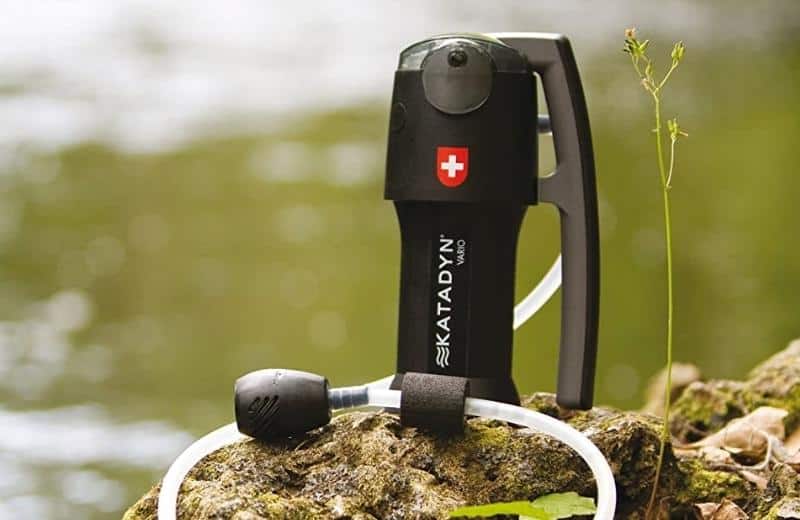
Smooth, Comfortable Pump Filtration
Using the Katadyn Vario filter is easy: just drop one end of the flexible hose in water, attach the other end to the filter, and pump. The system is one of the most comfortable and smoothest pumping filters of all those we reviewed. It also delivers filtered water very quickly, with a 2-liter-per-minute maximum flow rate that’s impressive given that it’s a hand-pump system and not powered by a battery. A unique feature of the filter is that it’s multi-flow, meaning that you can switch between the faster 2 liter-per-minute flow and a slower 1 liter-per-minute flow if you want to extend the filter life and you’re not in a hurry for filtered water.
The filter eliminates a broad range of contaminants in water, including bacteria, protozoa, algae, cysts, spores, sediment, chlorine, taste, and odor, making it a reliable option for filtering water sources in the US and Canada. It uses triple filtration for the job: first, a ceramic pre-filter to remove large sediment, followed by a pleated glass fiber layer to remove pathogens, and finally, a carbon filter, which targets chemicals and odors.
Maintenance is a little more challenging for this system compared to others. While it’s easy to take apart, there are lots of little components that need your attention. For instance, the o-rings need to be lubricated, and the ceramic pre-filter has its own cleaning tool. That means more things to think about while on your hiking or camping trip. On a more positive note, the system has a maximum 2,000-liter capacity, depending on your water quality, which is a pretty high volume compared to other pumps on the market.

MSR MiniWorks EX Microfilter Water Filter
Next on our list is the MSR MiniWorks EX Microfilter. This US-made pump filter removes particulates as small as 0.2 microns, including protozoan cysts, bacteria, and poor tastes and odors. The ceramic filter cartridge lasts for up to 500 gallons with regular cleaning, and the pump itself has a sturdy, rugged design that should withstand decades of use.



Specs
| Price | $119.95+ |
| Type | Pump |
| Filter Lifespan | 2,000 liters |
| Contaminants Removed | 99% of all Biologicals |
| Certifications or Testing | NSF P231 |
| Process | Ceramic + Carbon |
| Annual Cost | ~$40 |
| Warranty | Limited Lifetime |
The MiniWorks is one of the originals of its kind on the market, and as far as design is concerned, it’s virtually identical to the Katadyn Vario pump from the outside. The filter has a particularly durable construction that should withstand drops, knocks, and tens of uses without cracking or chipping (just make sure to avoid using it in freezing temperatures, which could cause it to split).
The cost of this MSR pump filter is only slightly more than the Katadyn model, at around $120. For that, you get the pump itself, as well as the super durable ceramic filter, which is contained in sturdy housing. There are only three main parts to the construction, with no small, fiddly components to maintain. We predicted we’d spend less than $40 on filter maintenance.
Best For:
Anyone looking to invest in the most reliable hand-pump filter that currently exists for long-term use.
What We Like:
- Reliably improves water quality
- Simple construction & easy to maintain
- Long-lasting, easy-clean filter
- One of the most durable pump filters available
What We Don’t Like:
- Pumping takes a long time
- Needs frequent filter flushing

Reliable Hand-Pump Filtration
The MiniWorks EX Microfilter has been in the game for a long time, and it’s amassed fans who have used the pump reliably for upwards of 20 years. That’s one of the main reasons why we were keen to review this filter for our list: it offers a failsafe and reliable performance over the decades that the newer pump filters can’t guarantee – and, if you weren’t already reassured enough, it’s backed by a lifetime warranty.
The filter itself is a ceramic and charcoal carbon block filter that removes contaminants down to 0.2 microns in size. It meets NSF protocol P231 for 99.9999% bacteria removal and 99.9% protozoa removal throughout its lifespan, even in “worst-case” water. Alongside pathogens, the filter reduces some chemicals, pesticides, tastes, and odors with the carbon core. As with the other manual pump filters on this list, hand-pumping is required to send water through the filter media. Just suspend the hose in water and pump the system to send clean water into the attached bag or a water bottle. The pump handle is ergonomic, making the pumping process pretty easy, but the rate of filtration decreases pretty quickly and requires more pumping to produce a smaller batch of water compared to the similar systems we reviewed. That means you’ll need to prepare for more of an arm workout and up to twice the wait for filtered water.
Super Long-Lasting Ceramic Filter
Again, like the majority of portable filters worth your money, the MiniWorks EX Microfilter has a reusable filter design, meaning you can repeatedly clean and renew the ceramic filter throughout its lifespan. Maintenance is particularly easy because no backflushing is required, which eliminates the need for the fiddly parts and equipment for this process. Instead, you just unscrew the filter and clean it off with a sponge. This should keep the filter cartridge going for a massive 2,000 liters – better than most other pump filters we’ve reviewed.
A convenient feature of this pump filter is that it’s compatible with some of the most popular water bottle brands, including the Nalgene and the Camelback, so you can pump water straight into one of these bottles if you prefer. Or you can use the pump in conjunction with the included storage bag, which can be folded when not in use and takes up minimal backpack space.

Epic Nalgene OG
Our runner-up filtered water bottle is the Epic Nalgene OG Woodsman. This portable bottled water filtration solution is designed for camping, hiking, and everyday use, and has a 1-liter holding capacity and a 300-gallon filter lifespan.
The Epic Nalgene OG Woodsman costs about $40 less than our top water bottle filter, the Grayl Ultrapress. However, you get three times the uses out of the Grayl model – 300 vs 100 uses – and the Epic Nalgene is a bit clunkier to use due to its straw filer design.
Specs
| Price | $43.20 |
| Type | Bottle |
| Filter Lifespan | 100 gallons |
| Contaminants Removed | 70+ |
| Certifications or Testing | NSF 42, 53, 401, P473, P231 |
| Process | Mechanical + Electroadhesion + Ion Exchange |
| Annual Cost | ~$90 |
| Warranty | Lifetime |
The Epic Nalgene OG Woodsman is a filter bottle with a straw that uses a built-in filter. When you suck water out of the straw, it first passes through a mechanical and ion exchange filter, which traps contaminants in its pores. There’s just one 32-ounce bottle size for this model, and that’s what we’re reviewing here.
At the time of our review, the OG Woodsman was priced at $60, or $48 if we signed up to Epic’s Clean Water Club, which sends customers filter replacements (also discounted) according to their pre-determined schedule. Our estimated annual maintenance cost was $90.
Best For:
Anyone looking to spend less money on a capable water filter bottle that they can use in all scenarios. Whether you’re looking to remove contaminants from public or natural water sources, the Epic Nalgene OG Woodsman has got you covered.
What We Like:
- Good 1-liter storage capacity
- Tested to NSF Standards for contaminant removal
- Targets both tap water and natural water contaminants
- Affordable
What We Don’t Like:
- Filter life is short
- Straw filter is quite difficult to suck through
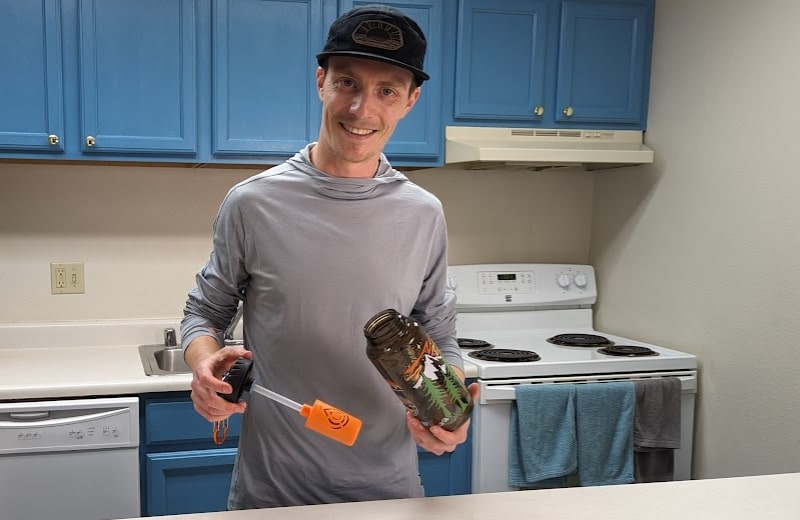
Natural & Tap Water Filtration
This filter bottle features Epic’s Everywhere filter, which uses dual filtration that has been independently tested to remove bacteria (including 99.99% E.Coli), protozoa (including 99.99% giardia), viruses, heavy metals, chlorine, agricultural pollutants, pharmaceuticals, and more. We like that you can use the bottle for natural and tap water sources because the filter’s technology removes contaminants from both.
One thing we loved about the Epic OG Woodsman was its large 1-liter storage capacity. We’d personally prefer to have a good stock of water on hiking trips, especially when we’re in locations where water sources are few and far between. Being able to fill the bottle with almost a full liter of water and knowing that you have this on hand is reassuring, although we know that some people might not want the weight and bulk of a large bottle in their backpack.
In all, the Epic OG Woodsman bottle is easy to use, and you can quickly assemble it before your trip and not have to fuss about with fiddly tubes and parts mid-hike. However, something we noted about this bottle is that the only way to access filtered water is through the straw. That means you can only use filtered water from the bottle for drinking – there’s no way to access it for cooking and other uses. Turning the bottle upside down isn’t enough to send water through the filter and out of the straw. You have to suck through the straw with quite a lot of force, which is another downside.
In terms of maintenance, the bottle has a wide-neck design, making it easy to clean between uses. Plus, Epic leads the pack with a lifetime warranty for this filter, so you’re protected against manufacturing flaws. The Everywhere filter lasts up to 75 gallons, and Epic recommends replacing it 3-4 times per year if you use the bottle regularly. That means you’ll need to commit to a lot more maintenance than the typical flushable and reusable portable filter.
Read the Full Review: Epic Nalgene OG Review
📚 Methodology: How We Tested The Best Portable Water Filters
When you’re deciding on the best portable water filter for you, there are a few important features to consider. We used these features as our criteria when reviewing the filters in this guide.
- Filter type – Our first job was to identify all the different types of portable water filters available and decide which filter types were best for which situations. Some of the most common portable filter types we identified were straw filters, gravity filters, pump filters, filtered water bottles, and UV purifiers (which use UV light to penetrate the harmful contaminants in water and deactivate them). We aimed to review at least 2-5 filters from each category to give us a clear understanding of the very best available portable water filters across the board.
- Contaminant removal – We also selected and ranked our shortlisted water filters based on the contaminants they were tested to remove. We found that while different methods of filtration could remove different contaminants, most of the portable filters we reviewed could virtually eliminate bacteria and protozoa at the very least. Some could also remove viruses, making them suitable for travel to developing countries, and some could remove chemicals, metals, and other impurities, further improving water quality.
- Flow rate – The flow rate of a portable water filter varies widely depending on the type of filter you buy. In our testing, we found that hand pump or electric pump filters typically offered the fastest rate of water production. Bottle or straw filters were next, while the hanging bag filters we reviewed had a slower, steadier flow rate because they relied on gravity filtration. Our advice is to consider your own personal use case, and whether you prefer to have instant access to clean drinking water or whether you’re happy to wait several minutes for the water to be filtered. Most portable filters can be backwashed as and when necessary to address flow rate issues caused by clogging.
- Filter capacity & lifespan – Most of the backwashable portable filters we tested had a decent capacity of around 3-5 years or longer. Some could even last 10 years, 20 years, or even longer, with proper care and maintenance (for instance, the Sawyer Products MINI filter has a lifespan of 100,000 gallons, or 200 years – so it should outlive you!).
- Size & weight – We knew that most folks looking for a portable filter would be camping, hiking, or participating in a similar outdoor activity where a bulky filter wouldn’t be convenient. We focused on finding a range of lightweight filter options, and identified straw, squeeze, and gravity bag water filters as being some of the best in this category. We also reviewed some slightly bulkier options for folks with more backpack space, including pump systems, and bottle filters, as well was larger gravity dispensers, which we knew would suit camping situations and offer the most convenient access to big batches of water for large families or groups.
- Ease of use – We rated a portable water filter’s ease of use based on the time and energy spent on setup and clean water production. In general, we found that pump filters had multiple parts and took the most physical effort, while straw filters and bottle filters were easy to use and had few parts (but many required manual sucking effort). The hanging gravity filters we tested had numerous parts and were easy (if not time-consuming) to use. We recommend considering whether you’d rather have a filter that takes no time to set up mid-hike, like a bottle filter, or whether you actually like the idea of assembling a filter and taking your time with the filtration process.
- Testing & certifications – When selecting the filters for this guide, we looked for those that had been tested to NSF Standards for their contaminant removal abilities, giving us the reassurance of third-party proof of performance. This was particularly important to us when reviewing portable water filters, since these need to be relied upon to remove dangerous disease-causing microorganisms.
- Cost – We knew that some folks would prefer to spend less than $50 upfront on a portable water filter, while others wouldn’t mind splashing out $100-$150 on a more comprehensive system. On average, we found that most portable water filters cost within the $25-$120 range. Typically, the larger and more complex the filter design, and the more components and accessories it comes with, the costlier it is. Most portable filters cost less than $50 a year to maintain, and some cost nothing at all due to their super-long filter lifespans.
- Maintenance – Finally, as far as maintenance is concerned, we prioritized portable water filters that needed as little maintenance as possible, knowing that most people wouldn’t want the hassle of replacing filters – especially not for a filter system that’s only used occasionally. Most of our shortlisted filters had flushable or backwashable filter cartridges, meaning they could be reused again and again for years without requiring a replacement.
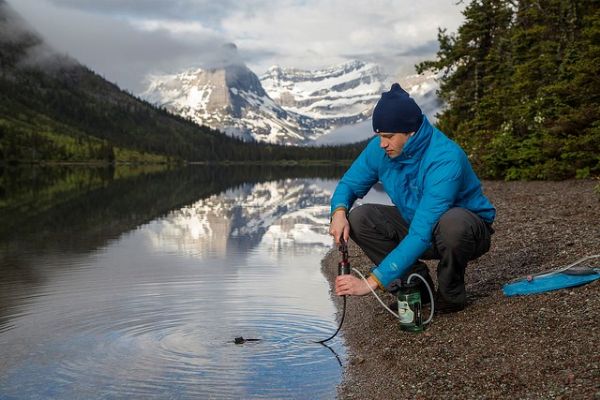
❔ Portable Water Filter Frequently Asked Questions
How effective are portable water filters?
The best portable water filters are effective enough to reliably remove all pathogens from natural water sources, keeping you safe on your travels. Look for filters with third-party testing, NSF certifications, or a WQA Gold Seal if you want proof that the filter works as advertised.
Do portable water filters remove bacteria?
Yes, the best portable water filters intended for use with natural water sources all remove bacteria. Bacteria is one of the larger pathogens, which means it’s one of the easiest to remove, alongside protozoa, with a micro or nanofilter. If you want to be certain that a portable water filter can remove bacteria, check to see if it has third-party testing or certifications as proof.
Can water filters remove viruses?
Some of the best portable water filters, like the Survivor Filter PRO and the Grayl Ultrapress, can remove some viruses from water. Viruses are tiny – even smaller than bacteria and protozoa – so they’re particularly difficult to remove and require a filter with tiny pores.
What is the best personal water purifier?
Based on our testing, the best personal water purifier is the Sawyer MINI because it’s effective, reliable, and durable, trapping contaminants as small as 0.1 microns and lasting up to 100,000 gallons.
Are portable water filters worth it?
Portable water filters are worth it if you spend a lot of time hiking or camping in the backcountry and you don’t want to boil your water every time you want a drink. Most portable water filters cost less than $100, with an average lifespan of 3-5 years – so they’re great value for money.
🤓 About Our Experts
Brian Campbell, WaterFilterGuru.com’s Founder, and Jennifer Byrd, our water treatment specialist, did the research, testing, and reviewing necessary for the products featured in this guide. You can learn more about Brian and Jennifer in the author bio below.

